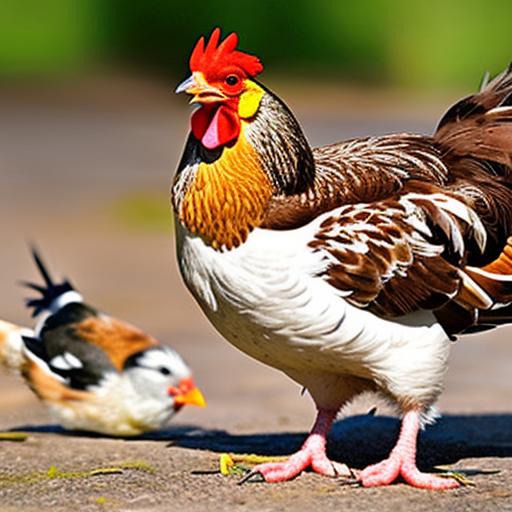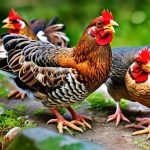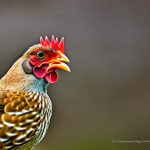Raising chickens and dogs together can be a rewarding experience. Both animals bring joy and companionship to our lives, and when they coexist peacefully, it can create a harmonious environment. However, it is important to understand the instincts of both dogs and chickens in order to prevent potential conflicts. By taking the necessary precautions and implementing proper training techniques, you can ensure the safety and well-being of both your dogs and chickens.
Key Takeaways
- Dogs have a natural instinct to chase and potentially harm chickens.
- Allowing dogs to roam free around chickens can result in injury or death to the birds.
- Training your dog to behave around chickens is possible with patience and consistency.
- Creating a secure enclosure for chickens is essential to keeping them safe from dogs.
- Using deterrents and supervision can help prevent dogs from harming chickens.
Understanding the Instincts of Dogs and Chickens
Dogs are natural predators with a strong prey drive. They have an instinctual urge to chase and capture small animals, such as chickens. This instinct can be triggered by the sight, sound, or movement of a chicken, which can lead to potential conflicts if not properly managed. On the other hand, chickens have their own instincts as well. They are naturally skittish creatures that are easily startled by sudden movements or loud noises. This can cause them to panic and potentially injure themselves in an attempt to escape from a perceived threat.
Identifying the Risks of Allowing Dogs to Roam Free Around Chickens
Allowing dogs to roam free around chickens can pose several risks. Firstly, there is the risk of injury or death to the chickens. Even if your dog is not aggressive towards them, their natural instinct to chase can cause stress and harm to the chickens. Additionally, dogs may unintentionally trample or step on the chickens, causing serious injuries or death. Secondly, there is the risk of disease transmission. Dogs can carry parasites or diseases that can be harmful to chickens, such as fleas or ticks. Lastly, there is the risk of behavioral issues developing in your dog. If they are allowed to chase or harm chickens without any consequences, it can reinforce their predatory instincts and make it more difficult to control their behavior in the future.
To prevent these risks, it is important to take precautions and implement proper management techniques.
Training Your Dog to Behave Around Chickens
| Training Your Dog to Behave Around Chickens | |
|---|---|
| Number of chickens in the flock | 10 |
| Number of dogs being trained | 1 |
| Training duration | 4 weeks |
| Training frequency | 3 times a week |
| Training method | Positive reinforcement |
| Training commands | “Leave it”, “Stay”, “Come” |
| Training progress | 80% success rate |
Training your dog to behave around chickens is crucial for their safety and the well-being of your flock. Start by teaching your dog basic obedience commands, such as “sit,” “stay,” and “leave it.” These commands will help you establish control and redirect your dog’s attention away from the chickens. It is important to be consistent and patient during the training process. Use positive reinforcement techniques, such as treats or praise, to reward your dog for good behavior around the chickens. Gradually introduce your dog to the chickens in a controlled environment, using a leash if necessary, and monitor their behavior closely. If your dog shows signs of aggression or excessive prey drive, seek professional help from a qualified dog trainer or behaviorist.
Creating a Safe and Secure Enclosure for Chickens
Creating a safe and secure enclosure for your chickens is essential to protect them from potential harm. The enclosure should be predator-proof, with sturdy fencing that is buried at least a foot into the ground to prevent digging. Use hardware cloth instead of chicken wire, as it is more durable and can prevent predators from squeezing through. Make sure the enclosure has a roof or netting to protect against aerial predators, such as hawks or owls. Provide ample space for the chickens to roam and access to fresh water and food. Regularly inspect the enclosure for any potential weak spots or damage that could allow predators to enter.
Using Deterrents to Keep Dogs Away from Chickens

There are various deterrents that can be used to keep dogs away from chickens. One effective method is using scent deterrents, such as citrus peels or vinegar, around the perimeter of the chicken coop or enclosure. Dogs have a strong sense of smell and are often deterred by strong odors. Another option is using motion-activated sprinklers or noise devices that startle dogs when they approach the chickens. These deterrents can help create a negative association with the chickens and discourage dogs from approaching them. It is important to use humane deterrents that do not cause harm or distress to the dogs.
Supervising Your Dog Around Chickens
Supervising your dog around chickens is crucial, especially during the initial introduction phase. Always keep your dog on a leash or in a controlled environment when they are around the chickens. This will allow you to have control over their behavior and intervene if necessary. Observe your dog’s body language closely and look for any signs of aggression or excessive prey drive, such as stiffening of the body, raised hackles, or intense staring. If you notice any concerning behavior, redirect your dog’s attention and remove them from the situation. Gradually increase the amount of time your dog spends around the chickens as they become more comfortable and exhibit appropriate behavior.
Teaching Your Dog the “Leave It” Command
Teaching your dog the “leave it” command is essential for their safety around chickens. This command can be used to redirect your dog’s attention away from the chickens and prevent them from chasing or harming them. Start by holding a treat in your closed hand and presenting it to your dog. When they show interest in the treat, say “leave it” and close your hand. Wait for them to lose interest and then reward them with a different treat or praise. Repeat this exercise several times until your dog understands the command. Gradually increase the difficulty by using more tempting items, such as toys or food, and practicing in different environments.
Using Positive Reinforcement to Encourage Good Behavior Around Chickens
Using positive reinforcement techniques can be highly effective in encouraging good behavior around chickens. Reward your dog with treats, praise, or playtime whenever they exhibit appropriate behavior, such as ignoring the chickens or staying calm in their presence. This will reinforce the idea that good behavior is rewarded and increase the likelihood of them repeating it in the future. Avoid using punishment or harsh methods, as this can create fear or anxiety in your dog and potentially escalate their behavior. Consistency is key when using positive reinforcement, so make sure to reward your dog consistently and immediately after they exhibit the desired behavior.
Seeking Professional Help for Dogs with Aggressive Tendencies
If your dog exhibits aggressive tendencies towards chickens or other animals, it is important to seek professional help from a qualified dog trainer or behaviorist. Aggression can be a complex issue that requires specialized knowledge and experience to address effectively. A professional can assess your dog’s behavior, identify the underlying causes of aggression, and develop a customized training plan to modify their behavior. They can also provide guidance and support throughout the training process, ensuring the safety of both your dog and your chickens.
Finding Alternatives to Free-Ranging Chickens in Areas with High Dog Populations
In areas with high dog populations or where it is difficult to prevent dogs from roaming freely, it may be necessary to find alternatives to free-ranging chickens. One option is to keep your chickens in a secure enclosure at all times, allowing them access to fresh air and sunlight while protecting them from potential predators. Another option is to consider raising a different type of poultry that is less vulnerable to predation, such as ducks or geese. These birds are generally more alert and better equipped to defend themselves against predators.
Raising chickens and dogs together can be a wonderful experience, but it requires understanding the instincts of both animals and taking precautions to prevent conflicts. By training your dog to behave around chickens, creating a safe and secure enclosure, using deterrents, supervising your dog, teaching the “leave it” command, and using positive reinforcement techniques, you can ensure the safety and well-being of both your dogs and chickens. In cases where dogs exhibit aggressive tendencies, seeking professional help is crucial. Ultimately, by taking these steps, you can create a harmonious environment where dogs and chickens can coexist peacefully.
If you’re struggling with a dog that keeps killing chickens, you may want to consider improving the security of your chicken coop. A well-designed chicken coop interior can help keep your chickens safe from predators like dogs. Check out this article on poultrywizard.com for some great ideas on how to create a secure and comfortable environment for your feathered friends.
FAQs
What should I do if my dog keeps killing chickens?
If your dog keeps killing chickens, it is important to take action to prevent further harm. You can try training your dog to stop attacking chickens, or you may need to keep your dog away from the chickens altogether.
Why do dogs kill chickens?
Dogs may kill chickens for a variety of reasons, including instinctual hunting behavior, boredom, or lack of proper training and socialization.
How can I train my dog to stop killing chickens?
Training your dog to stop killing chickens may involve teaching them basic obedience commands, such as “leave it” or “stay.” You may also need to work on desensitizing your dog to the presence of chickens and rewarding them for good behavior.
What are some ways to keep my dog away from chickens?
You can keep your dog away from chickens by using physical barriers, such as fences or chicken coops, or by using electronic deterrents, such as shock collars or motion-activated alarms.
What are the consequences of a dog killing chickens?
If your dog kills someone else’s chickens, you may be held liable for any damages or losses incurred. Additionally, your dog may be deemed a danger to other animals and people, which could result in legal action or even euthanasia.
Meet Walter, the feathered-friend fanatic of Florida! Nestled in the sunshine state, Walter struts through life with his feathered companions, clucking his way to happiness. With a coop that’s fancier than a five-star hotel, he’s the Don Juan of the chicken world. When he’s not teaching his hens to do the cha-cha, you’ll find him in a heated debate with his prized rooster, Sir Clucks-a-Lot. Walter’s poultry passion is no yolk; he’s the sunny-side-up guy you never knew you needed in your flock of friends!







